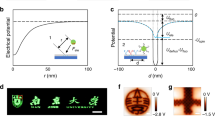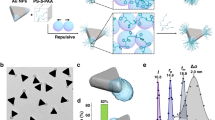Abstract
Patterning of colloidal particles with chemically or topographically distinct surface domains (patches) has attracted intense research interest1,2,3. Surface-patterned particles act as colloidal analogues of atoms and molecules4,5, serve as model systems in studies of phase transitions in liquid systems6, behave as ‘colloidal surfactants’7 and function as templates for the synthesis of hybrid particles8. The generation of micrometre- and submicrometre-sized patchy colloids is now efficient9,10,11, but surface patterning of inorganic colloidal nanoparticles with dimensions of the order of tens of nanometres is uncommon. Such nanoparticles exhibit size- and shape-dependent optical, electronic and magnetic properties, and their assemblies show new collective properties12. At present, nanoparticle patterning is limited to the generation of two-patch nanoparticles13,14,15, and nanoparticles with surface ripples16 or a ‘raspberry’ surface morphology17. Here we demonstrate nanoparticle surface patterning, which utilizes thermodynamically driven segregation of polymer ligands from a uniform polymer brush into surface-pinned micelles following a change in solvent quality. Patch formation is reversible but can be permanently preserved using a photocrosslinking step. The methodology offers the ability to control the dimensions of patches, their spatial distribution and the number of patches per nanoparticle, in agreement with a theoretical model. The versatility of the strategy is demonstrated by patterning nanoparticles with different dimensions, shapes and compositions, tethered with various types of polymers and subjected to different external stimuli. These patchy nanocolloids have potential applications in fundamental research, the self-assembly of nanomaterials, diagnostics, sensing and colloidal stabilization.
This is a preview of subscription content, access via your institution
Access options
Subscribe to this journal
Receive 51 print issues and online access
$199.00 per year
only $3.90 per issue
Buy this article
- Purchase on Springer Link
- Instant access to full article PDF
Prices may be subject to local taxes which are calculated during checkout




Similar content being viewed by others
Change history
05 October 2016
Present addresses were added for author O.G., who is currently associated with the Center for Functional Nanomaterials, Brookhaven National Laboratory, and with the Departments of Chemical Engineering and of Applied Physics and Applied Mathematics at Columbia University.
References
Bianchi, E., Blaak, R. & Likos, C. N. Patchy colloids: state of the art and perspectives. Phys. Chem. Chem. Phys. 13, 6397–6410 (2011)
Preisler, Z., Vissers, T., Munaŏ, G., Smallenburg, F. & Sciortino, F. Equilibrium phases of one-patch colloids with short-range attractions. Soft Matter 10, 5121–5128 (2014)
Chen, Q., Bae, S. C. & Granick, S. Directed self-assembly of a colloidal kagome lattice. Nature 469, 381–384 (2011)
Glotzer, S. C. & Solomon, M. J. Anisotropy of building blocks and their assembly into complex structures. Nat. Mater. 6, 557–562 (2007)
Gröschel, A. H. et al. Guided hierarchical co-assembly of soft patchy nanoparticles. Nature 503, 247–251 (2013)
Kern, N. & Frenkel, D. Fluid–fluid coexistence in colloidal systems with short-ranged strongly directional attraction. J. Chem. Phys. 118, 9882–9889 (2003)
Binks, B. P. Particles as surfactants: similarities and differences. Curr. Opin. Colloid Interface Sci. 7, 21–41 (2002)
Chen, T., Chen, G., Xing, S., Wu, T. & Chen, H. Scalable routes to Janus Au-SiO2 and ternary Ag-Au-SiO2 nanoparticles. Chem. Mater. 22, 3826–3828 (2010)
Wang, Y. et al. Colloids with valence and specific directional bonding. Nature 491, 51–55 (2012)
Pawar, A. B. & Kretzschmar, I. Fabrication, assembly, and application of patchy particles. Macromol. Rapid Commun. 31, 150–168 (2010)
Sacanna, S. & Pine, D. J. Shape-anisotropic colloids: building blocks for complex assemblies. Curr. Opin. Colloid Interf. Sci. 16, 96–105 (2011)
Nie, Z. H., Petukhova, A. & Kumacheva, E. Properties and emerging applications of self-assembled structures of inorganic nanoparticles. Nat. Nanotechnol. 5, 15–25 (2010)
Lattuada, M. & Hatton, T. A. Synthesis, properties and applications of Janus nanoparticles. Nano Today 6, 286–308 (2011)
Andala, D. M., Shin, S. H. R., Lee, H. Y. & Bishop, K. J. M. Templated synthesis of amphiphilic nanoparticles at the liquid-liquid interface. ACS Nano 6, 1044–1050 (2012)
Vilain, C., Goettmann, F., Moores, A., Le Floch, P. & Sanchez, C. Study of metal nanoparticles stabilised by mixed ligand shell: a striking blue shift of the surface-plasmon band evidencing the formation of Janus nanoparticles. J. Mater. Chem. 17, 3509–3514 (2007)
Jackson, A. M., Myerson, J. W. & Stellacci, F. Spontaneous assembly of subnanometre ordered domains in the ligand shell of monolayer-protected nanoparticles. Nat. Mater. 3, 330–336 (2004)
Bao, C. et al. Effect of molecular weight on lateral microphase separation of mixed homopolymer brushes grafted on silica particles. Macromolecules 47, 6824–6835 (2014)
Williams, D. R. M. Grafted polymers in bad solvents: octopus surface micelles. J. Phys. II 3, 1313–1318 (1993)
Zhulina, E. B., Birshtein, T. M., Priamitsyn, V. A. & Klushin, L. I. Inhomogeneous structure of collapsed polymer brushes under deformation. Macromolecules 28, 8612–8620 (1995)
Koutsos, V., van der Vegte, E. W., Pelletier, E., Stamouli, A. & Hadziioannou, G. Structure of chemically end-grafted polymer chains studied by scanning force microscopy in bad-solvent conditions. Macromolecules 30, 4719–4726 (1997)
Choi, B. C., Choi, S. & Leckband, D. E. Poly(N-isopropyl acrylamide) brush topography: dependence on grafting conditions and temperature. Langmuir 29, 5841–5850 (2013)
Erathodiyil, N. & Ying, J. Y. Functionalization of inorganic nanoparticles for bioimaging applications. Acc. Chem. Res. 44, 925–935 (2011)
Minelli, C., Lowe, S. B. & Stevens, M. M. Engineering nanocomposite materials for cancer therapy. Small 6, 2336–2357 (2010)
Saha, K., Agasti, S. S., Kim, C., Li, X. & Rotello, V. M. Gold nanoparticles in chemical and biological sensing. Chem. Rev. 112, 2739–2779 (2012)
Wolf, B. A. & Willms, M. M. Measured and calculated solubility of polymers in mixed-solvents-co-non-solvency. Makromol. Chem. 179, 2265–2277 (1978)
Bürgi, T. Properties of the gold–sulphur interface: from self-assembled monolayers to clusters. Nanoscale 7, 15553–15567 (2015)
Rubinstein, M. & Colby, R. H. Polymer Physics 53 (Oxford Univ. Press, 2003)
Zohar, N., Chuntonov, L. & Haran, G. The simplest plasmonic molecules: metal nanoparticle dimers and trimers. J. Photochem. Photobiol. C 21, 26–39 (2014)
Choueiri, R., Klinkova, A., Thérien-Aubin, H., Rubinstein, M. & Kumacheva, E. Structural transitions in nanoparticle assemblies governed by competing nanoscale forces. J. Am. Chem. Soc. 135, 10262–10265 (2013)
Klinkova, A. et al. Structural and optical properties of self-assembled chains of plasmonic nanocubes. Nano Lett. 14, 6314–6321 (2014)
Lukach, A., Liu, K., Thérien-Aubin, H. & Kumacheva, E. Controlling the degree of polymerization, bond lengths and bond angles of plasmonic polymers. J. Am. Chem. Soc. 134, 18853–18859 (2012)
Khabibullin, A., Mastan, E., Matyjaszewski, K. & Zhu, S. Surface-initiated atom transfer radical polymerization. Adv. Polym. Sci. 270, 29–76 (2015)
Acknowledgements
We thank the Connaught Foundation and the National Science and Engineering Research Council of Canada (Discovery and Canada Research Chair programmes) for financial support of this work. E.B.Z. acknowledges partial support from the Russian Foundation for Basic Research (grant 14-03-00372a) and from the Government of Russian Federation (grant 074-U01). M.R. acknowledges financial support from the National Science Foundation (grants DMR-1309892, DMR-1436201 and DMR-1121107), the National Institutes of Health (grants P01-HL108808 and 1UH2HL123645), and the Cystic Fibrosis Foundation. Research was in part carried out at the Center for Functional Nanomaterials, Brookhaven National Laboratory supported by the US Department of Energy, Office of Basic Energy Sciences (under contract number DE-SC0012704). R.M.C. acknowledges the Natural Sciences and Engineering Research Council of Canada for a PGS-D scholarship. A.K. acknowledges an Ontario Trillium Scholarship. We thank M. Michaelis and S. Lin for initiating preliminary experiments and I. Gourevich for help with imaging experiments.
Author information
Authors and Affiliations
Contributions
E.K. and R.M.C. proposed the approach and designed the experiments for nanoparticle surface patterning. R.M.C. synthesized and surface-patterned polystyrene-coated gold nanospheres, nanodumbbells and nanorods, and conducted self-assembly experiments of patchy nanospheres in the presence of excess polymer. E.G. synthesized and surface-patterned polystyrene-capped gold nanospheres and silver nanocubes, as well as poly(N-vinyl carbazole)-functionalized nanospheres. E.G. and E.M.L. determined polystyrene grafting density on nanosphere surfaces. H.T.-A. synthesized polystyrene-co-PI and poly(4-vinyl pyridine) and surface-patterned nanosphere surfaces. R.M.C., E.G. and H.T.-A. statistically characterized the morphology of patchy nanospheres. A.K. synthesized triangular silver nanoprisms and nanocubes and conducted experiments on nanocube self-assembly. A.Q.-F. surface-patterned gold nanocubes and conducted self-assembly of patchy nanospheres. L.H. performed tomography experiments and H.L.X. and O.G. interpreted the data. E.B.Z. and M.R. developed the theoretical model describing polymer segregation on the nanosphere surface.
Corresponding author
Ethics declarations
Competing interests
The authors declare no competing financial interests.
Additional information
Reviewer Information
Nature thanks I. Kretzschmar, D. Williams and the other anonymous reviewer(s) for their contribution to the peer review of this work.
Supplementary information
Supplementary Information
This file contains a description of the methods (synthesis, surface functionalization, polymer segregation experiments, self-assembly experiments, tomography, cross-linking), a description of the theoretical model with relevant equations, Supplementary Figures 1-27 (characterization of nanoparticles, statistical analyses of patchy species, schematics for theoretical model) and Supplementary Tables 1-3 (summaries of conditions used in methods). (PDF 4203 kb)
A rotational view of three dimensional reconstruction of the polymer coated gold particle around the x-axis
A rotational view of three dimensional reconstruction of the polymer coated gold particle around the x-axis (MPG 18417 kb)
A rotational view of three dimensional reconstruction of the polymer coated gold particle around the y-axis
A rotational view of three dimensional reconstruction of the polymer coated gold particle around the y-axis (MPG 18113 kb)
Rights and permissions
About this article
Cite this article
Choueiri, R., Galati, E., Thérien-Aubin, H. et al. Surface patterning of nanoparticles with polymer patches. Nature 538, 79–83 (2016). https://doi.org/10.1038/nature19089
Received:
Accepted:
Published:
Issue Date:
DOI: https://doi.org/10.1038/nature19089
This article is cited by
-
No ground truth needed: unsupervised sinogram inpainting for nanoparticle electron tomography (UsiNet) to correct missing wedges
npj Computational Materials (2024)
-
Investigation on electrical, structural, magnetic, optical properties and EPR studies of CdCu2O3 composite oxide prepared via sol–gel method
Indian Journal of Physics (2024)
-
Temperature/pH dual-responsive reversible morphology evolution of block copolymer microparticles under three-dimensional confinement
Science China Chemistry (2023)
-
Self-erasable dynamic surface patterns via controllable elastic modulus boosting multi-encoded and tamper-proof information storage
Nano Research (2023)
-
Symmetry-breaking in patch formation on triangular gold nanoparticles by asymmetric polymer grafting
Nature Communications (2022)
Comments
By submitting a comment you agree to abide by our Terms and Community Guidelines. If you find something abusive or that does not comply with our terms or guidelines please flag it as inappropriate.



